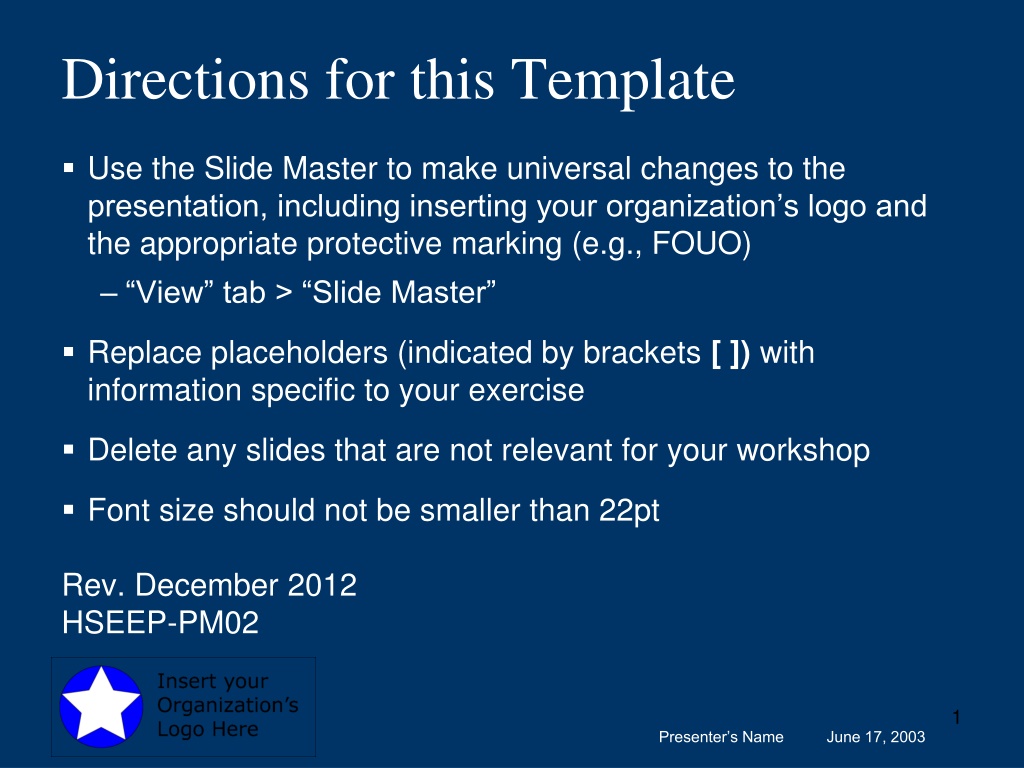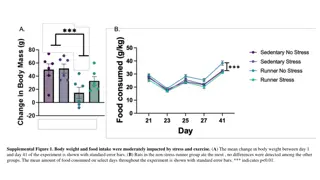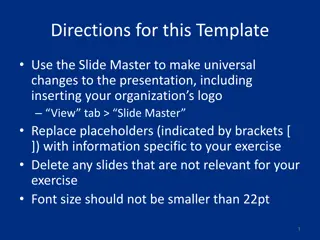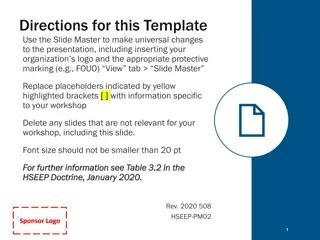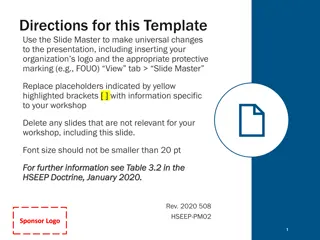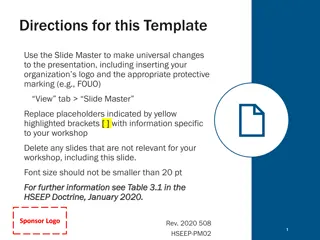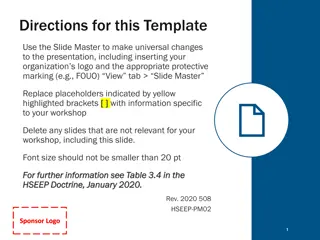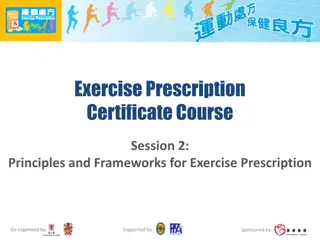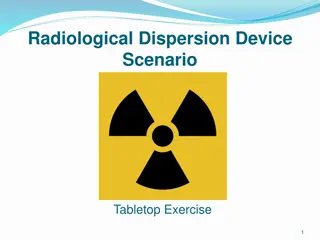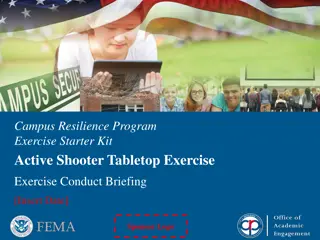Comprehensive Training and Exercise Planning Workshop Overview
This presentation provides an in-depth overview of the Homeland Security Exercise and Evaluation Program (HSEEP), encompassing core principles, capabilities-based planning, and multi-year exercise program management. It emphasizes the importance of integrated planning, whole community collaboration, and progressive methodology in enhancing preparedness and response capabilities. The session aims to equip participants with the knowledge and tools necessary to develop effective training and exercise plans tailored to their organization's needs and priorities.
Download Presentation

Please find below an Image/Link to download the presentation.
The content on the website is provided AS IS for your information and personal use only. It may not be sold, licensed, or shared on other websites without obtaining consent from the author. Download presentation by click this link. If you encounter any issues during the download, it is possible that the publisher has removed the file from their server.
E N D
Presentation Transcript
Directions for this Template Use the Slide Master to make universal changes to the presentation, including inserting your organization s logo and the appropriate protective marking (e.g., FOUO) View tab > Slide Master Replace placeholders (indicated by brackets [ ]) with information specific to your exercise Delete any slides that are not relevant for your workshop Font size should not be smaller than 22pt Rev. December 2012 HSEEP-PM02 1 Presenter s Name June 17, 2003
Training and Exercise Planning Workshop (TEPW) [Sponsor Organization] [Date]
Welcome and Introductions [Name] [Organization] 3 Presenter s Name June 17, 2003
Agenda [Time] Homeland Security Exercise and Evaluation Program (HSEEP) Overview [Time] Capabilities-based Planning Overview [Time] Review of Prior Multi-Year Training and Exercise Plan (TEP) [Time] TEPW Purpose [Time] Workshop Activities [Time] Review [Time] Next Steps [Time] Closing Remarks 4 Presenter s Name June 17, 2003
HSEEP Overview HSEEP doctrine consists of an integrated set of core principles that frame a common approach to exercises HSEEP Principles: Guided by elected and appointed officials Capability-based, objective driven Whole Community integration Informed by risk Common methodology Progressive planning approach 5 Presenter s Name June 17, 2003
HSEEP Cycle Establishing multi-year exercise program priorities and developing a multi-year TEP are key pieces of Exercise Program Management within the HSEEP methodology 6 Presenter s Name June 17, 2003
Capabilities-based Planning Overview The National Preparedness Goal identifies a series of core capabilities across the prevention, protection, mitigation, response, and recovery mission areas Through HSEEP, organizations can use exercises as a way to examine current and required core capability levels and identify gaps. Exercises focus on assessing performance against capability-based objectives 7 Presenter s Name June 17, 2003
Review of Prior Multi-year TEP [Insert highlights from the previous multi-year TEP and an update on the progress against the program priorities and multi-year schedule] 8 Presenter s Name June 17, 2003
TEPW Purpose The purpose of the TEPW is to use the guidance provided by senior officials to identify and set exercise program priorities and develop a multi-year schedule of exercise events and supporting training activities to meet those priorities Establish Exercise Program Priorities Identify Factors for Consideration Link Factors to Core Capabilities Develop a Multi-year Schedule 9 Presenter s Name June 17, 2003
Attendee Expectations Have a working knowledge of HSEEP Be familiar with the National Preparedness Goal and National Preparedness System Have access to organizational plans, policies, procedures, and other relevant documents (including After-Action Reports) Have the authority to establish or revise organizational priorities 10 Presenter s Name June 17, 2003
Workshop Activities The TEPW focuses on 4 primary activities and associated tasks: Activity 1: Identify Factors for Consideration Task 1.1: Identify threats and hazards Task 1.2: Identify validated and non-validated areas for improvement Task 1.3: Identify external sources and requirements Task 1.4: Identify accreditation standards or regulations Activity 2: Link Factors to Core Capabilities 11 Presenter s Name June 17, 2003
Workshop Activities (contd) Activity 3: Establish Exercise Program Priorities Activity 4: Develop a Multi-year Schedule Task 4.1: Identify potential exercises Task 4.2: Identify potential training Task 4.3: Update/build the draft multi-year schedule 12 Presenter s Name June 17, 2003
Activity 1 Establish Exercise Program Priorities Identify Factors for Consideration Link Factors to Core Capabilities Develop a Multi-year Schedule Factors for consideration are they key elements that influence the selection of exercise program priorities The list of factors is intended to help organizations consider the full range of factors impacting their exercise and preparedness programs 13 Presenter s Name June 17, 2003
Activity 1 Tasks Overview During this activity, we will focus on the identifying the following: Task 1.1: Task 1.2: Task 1.3: Task 1.4: 14 Presenter s Name June 17, 2003
Task 1.1: Identify Threats and Hazards Objective: Identify any significant threats and hazards Instructions: 1.Locate the other members of your organization 2.As a group, develop a list of the top threats and hazards impacting your organization 3.Record these threats and hazards 4.Choose a group member to brief the findings Consider: National threats and hazards Organizational threats and hazards THIRA and local risk assessments Hazard vulnerability analysis 15 Presenter s Name June 17, 2003
Task 1.2: Identify Areas for Improvement Objective: Identify any significant strengths and areas for improvement Instructions: 1.Locate the other members of your organization 2.As a group, develop a list of your organization s top strengths and areas for improvement 3.Record these strengths/areas for improvement 4.Choose a group member to brief the findings Consider: Strengths to be shared with other organizations Exercise and real-world event corrective actions Identified and/or perceived areas for improvement 16 Presenter s Name June 17, 2003
Task 1.3: Identify External Sources and Requirements Objective: Identify any significant external sources and requirements Instructions: 1.Locate the other members of your organization 2.As a group, develop a list of your organization s key external sources and requirements 3.Record these sources and requirements 4.Choose a group member to brief the findings Consider: Industry reports State or national preparedness reports State or national homeland security strategies Homeland security policy 17 Presenter s Name June 17, 2003
Task 1.4: Identify Accreditation Standards and Regulations Objective: Identify any significant accreditation standards and regulations Instructions: 1.Locate the other members of your organization 2.As a group, develop a list of your organization s key accreditation standards and regulations 3.Record these standards and regulations 4.Choose a group member to brief the findings Consider: Accreditation standards Grants or funding-specific requirements Occupational Safety and Health Administration (OSHA) regulations Legislative requirements 18 Presenter s Name June 17, 2003
Activity 2 Establish Exercise Program Priorities Identify Factors for Consideration Link Factors to Core Capabilities Develop a Multi-year Schedule The National Preparedness Goal outlines district core capabilities across five preparedness mission areas Organizations can use exercises as a way to examine current and required core capability levels and identify gaps Linking the factors identified in Activity 1 to core capabilities will help identify the areas most in need of attention 19 Presenter s Name June 17, 2003
Activity 2: Link Factors to Core Capabilities Objective: Link the factors identified in Activity 1 to core capabilities Instructions: 1.Assign core capabilities to each factor recorded during Activity 1 2.If multiple core capabilities are associated with a factor, determine which is primary capability 3.Identify and prioritize the most common core capabilities Consider: Threats and hazards Strengths and areas for improvement External sources and requirements Accreditation standards and regulations 20 Presenter s Name June 17, 2003
Activity 3 Establish Exercise Program Priorities Identify Factors for Consideration Link Factors to Core Capabilities Develop a Multi-year Schedule Exercise program priorities are the strategic, high-level priorities that guide the overall exercise program These priorities inform the development of exercise objectives, ensuring individual exercises evaluate and assess core capabilities in a coordinated and integrated fashion 21 Presenter s Name June 17, 2003
Activity 3: Establish Exercise Program Priorities Objective: Achieve consensus on the priorities that will guide the exercise program for the next [#] years Instructions: 1.Identify 3-5 priorities on which to focus training and exercises 2.Priorities should be at the strategic level 3.Consider priorities from a holistic perspective, not just your individual organization. These priorities are not meant to supersede their organizations priorities Consider: Factors identified in Activity 1 Priority core capabilities identified in Activity 2 Elected and appointed officials guidance 22 Presenter s Name June 17, 2003
Activity 4 Establish Exercise Program Priorities Identify Factors for Consideration Link Factors to Core Capabilities Develop a Multi-year Schedule The multi-year schedule outlines the exercises and associated training events that will address the exercise program priorities The multi-year schedule should reflect a progressive approach: Exercises are aligned to a common set of exercise program priorities Exercises increase in complexity over time Exercises should be supported at each step with training resources 23 Presenter s Name June 17, 2003
Activity 4 Tasks Overview During this activity, we will focus on the following tasks: Task 4.1: Identify Potential Exercises Task 4.2: Identify Training Task 4.3: Update/Build the Multi-year Schedule 24 Presenter s Name June 17, 2003
Task 4.1: Identify Potential Exercises Objective: Identify potential exercises for inclusion in the multi-year schedule Instructions: 1.Locate the other members of your organization 2.As a group, identify potential exercises for the multi-year schedule 3.Record the exercises, including the focus, date, and other known information 4.Choose a group member to brief the findings Consider: Pre-planned exercises Standing exercise requirements Additional exercises to address program priorities 25 Presenter s Name June 17, 2003
Task 4.2: Identify Potential Training Objective: Identify potential training events for inclusion in the multi-year schedule Instructions: 1.Locate the other members of your organization 2.As a group, identify potential training events 3.Record the potential training events, including the focus, audience, and date 4.Choose a group member to brief the findings Consider: Training to support specific exercises Required training Additional training to meet capability gaps or address program priorities 26 Presenter s Name June 17, 2003
Task 4.3: Update/Build the Draft Multi-year Schedule Objective: Update or build the multi-year training and exercise schedule Instructions: 1.Select exercises from the proposed list and identify tentative exercise conduct dates 2.Select training events and identify tentative conduct dates, scheduling around exercises, as appropriate Consider: Exercises that address program priorities and priority core capabilities Exercises that promote collaboration 27 Presenter s Name June 17, 2003
Populate the Draft Multi-year Schedule Year 1: 20xx Organ- ization Jan Feb Mar Apr May Jun Jul Aug Sep Oct Nov Dec Org 1 Org 2 Org 3 Org 4 Org 5 28 Presenter s Name June 17, 2003
Populate the Draft Multi-year Schedule (cont d) Year 1: 20xx Organ- ization Jan Feb Mar Apr May Jun Jul Aug Sep Oct Nov Dec Org 1 Org 2 Org 3 Org 4 Org 5 29 Presenter s Name June 17, 2003
Review The selected exercise program priorities include: [insert exercise program priorities] The exercises and trainings selected for inclusion in the TEP include: [insert exercises and trainings] 30 Presenter s Name June 17, 2003
Next Steps Develop and distribute TEPW Summary Develop Multi-year TEP [insert additional items as needed] 31 Presenter s Name June 17, 2003
Conclusion 32 Presenter s Name June 17, 2003
